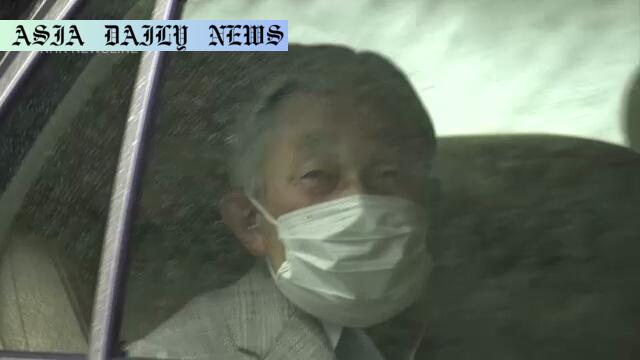Emperor Emeritus Akihito hospitalized in Tokyo for heart examination after signs of myocardial ischemia were detected.
- Japan’s Emperor Emeritus Akihito, 91, was admitted to a Tokyo hospital for heart exams.
- Potential myocardial ischemia detected; no symptoms reported by the Emperor Emeritus.
- Akihito has a history of heart conditions like right heart failure and angina.

Background of Emperor Emeritus Akihito’s Hospitalization
On Tuesday, Japan’s Emperor Emeritus Akihito, aged 91, was admitted to the University of Tokyo Hospital for a thorough heart examination. Accompanied by Empress Emerita Michiko, he departed from the Akasaka Estate for this critical medical visit. The Imperial Household Agency has revealed that Sunday tests indicated a high probability of myocardial ischemia, a condition where the coronary arteries fail to adequately supply blood to the heart muscle. Despite these troubling results, the Emperor Emeritus has not experienced any symptoms, adding an enigmatic element to this unfolding health concern.
History of Past Health Challenges
Emperor Emeritus Akihito has encountered various health issues over the years. In 2012, he underwent coronary bypass surgery following a diagnosis of angina. Recent years have seen him managing other heart-related concerns, including right heart failure diagnosed in 2022. This condition required him to adopt a controlled lifestyle, including medication and restricted fluid intake. His medical journey reflects resilience and the meticulous care offered to a prominent figure of his stature. This recent hospitalization marks the first in 13 years for him, showcasing the seriousness of the situation while reflecting on a well-managed medical history since his retirement in 2019.
Understanding Myocardial Ischemia
Myocardial ischemia is a potentially grave condition caused by reduced blood flow to the heart. Factors like underlying coronary artery disease can exacerbate this. In the case of the Emperor Emeritus, his history of angina and heart failure may heighten the risks. The absence of symptoms such as chest pain or fatigue could indicate an early stage of the problem. It is imperative for his doctors to conduct detailed diagnostic tests to ascertain the severity of the condition and take appropriate measures. His advanced age places him at a higher-risk category, warranting vigilance and expert management.
The Broader Implications
The health of long-standing public figures often resonates beyond personal concerns, impacting societal morale. Emperor Emeritus Akihito is a revered figure in Japan, symbolizing decades of service and continuity within the Imperial lineage. News of his health woes not only mobilizes governmental and medical resources but also evokes public concerns. In Japan, where the Emperor is both a cultural and historical icon, ensuring Akihito’s well-being transcends medical realms, embracing national sentiment. This latest health scare underscores the importance of proactive care, especially for aging leaders whose symbolic value is deeply intertwined with national identity and collective history.
Looking Ahead
As Emperor Emeritus Akihito undergoes detailed tests to address this concern, the focus remains on his recovery and the mitigation of future complications. His well-documented medical schedule suggests meticulous planning, supported by expert care teams. Regardless of age or prominence, heart health serves as a stark reminder that proactive monitoring and attention to subtle signs can lead to improved outcomes. The Japanese public, in their collective concern, will undoubtedly follow updates with keen interest, hoping for positive news regarding their beloved former Emperor.



Commentary
An Enduring Figure of Resilience
The recent hospitalization of Emperor Emeritus Akihito is a solemn reminder of his advanced age and the challenges that come with maintaining health in one’s 90s. It is heartening, however, to observe how proactive attention to potential health risks drives him and his caregivers. His impressive history of service, coupled with dignity and grace, continues to ironcast his legacy, even as he confronts these health challenges head-on. Though retired, Akihito remains an integral symbol of Japan’s modern identity, forging a connection between tradition and progression.
A Nation’s Collective Worry
In Japan, the Imperial family holds a profound place in the cultural and historical narrative. News of Akihito’s health undoubtedly stirs considerable concern among citizens, many of whom hold him in the highest regard. This moment reflects the unique bond between the public and its traditions, as a nation collectively extends its goodwill and hopes for his speedy recovery. The symbolism of Akihito’s ongoing health journey provides both inspiration and introspection for a country that cherishes longevity and respect for elders.
Beyond a Personal Perspective
While the focus currently is on the health of one individual, this incident also emphasizes broader health concerns for the elderly. The emphasis on proactive care, especially in early detection of conditions like myocardial ischemia, highlights the importance of regular medical check-ups and lifestyle management. It serves as a poignant reminder that no one, not even a figure as august as the Emperor Emeritus, is immune to the rigors of aging. By sharing in his journey, Japanese society gains an example of endurance, humility, and the need for compassion, both personal and shared.